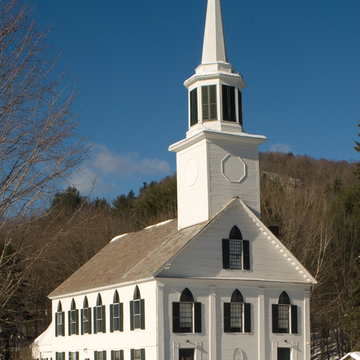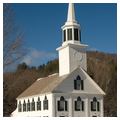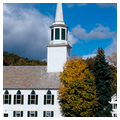The much-photographed church that dominates the north side of the Townshend common is a survivor in a village center that has been ravaged by multiple fires. Built as the community's meetinghouse, this location indicated a shift in importance from the town's initial settlement in West Townshend to the more central village, though when this took place is little evident in the building's present appearance. The building was originally five bays deep with the long side and central door facing the green. Sometime between 1832 and 1848, a floor was inserted at gallery level, in a fashion typical of Vermont's small towns, to create separate quarters for town and church. An additional bay that enclosed stairs and incorporated the tower with its octagonal belfry and spire was added to the east. The eastern facade, now the effective main front of the building, was detailed with both Greek and Gothic forms, including pilasters, gable pediment, and upper windows with pointed-arched shutters. This stylistic mix is found on a number of Windham County buildings from this period, most notably on the Congregational Church (1839; 11 Church Street) in nearby Newfane. There, the motifs are so similar as to suggest that the two buildings were by the same builder. The church purchased the ground floor from the town for use as a vestry in 1908. While the main building is largely unchanged, there is a new kitchen wing and the spire was reconstructed after being struck by lightning in 1960.
You are here
Congregational Meetinghouse
If SAH Archipedia has been useful to you, please consider supporting it.
SAH Archipedia tells the story of the United States through its buildings, landscapes, and cities. This freely available resource empowers the public with authoritative knowledge that deepens their understanding and appreciation of the built environment. But the Society of Architectural Historians, which created SAH Archipedia with University of Virginia Press, needs your support to maintain the high-caliber research, writing, photography, cartography, editing, design, and programming that make SAH Archipedia a trusted online resource available to all who value the history of place, heritage tourism, and learning.














